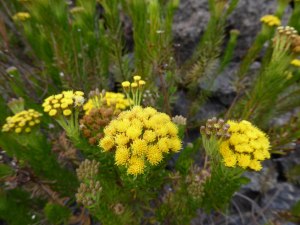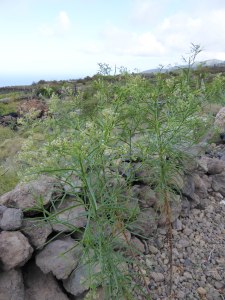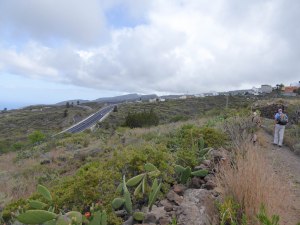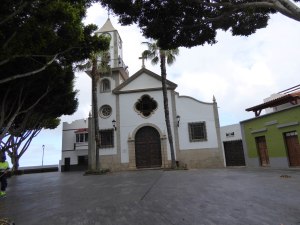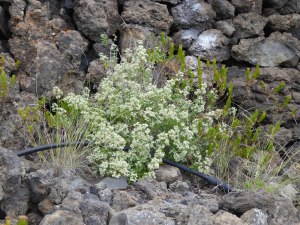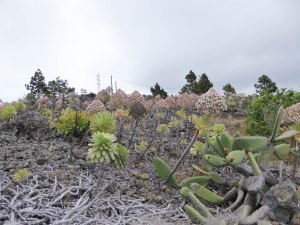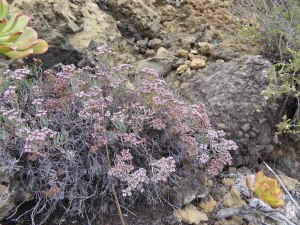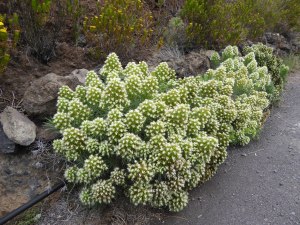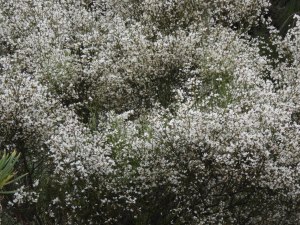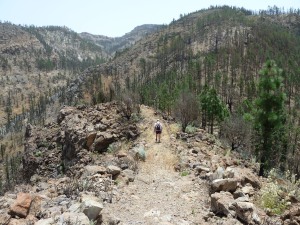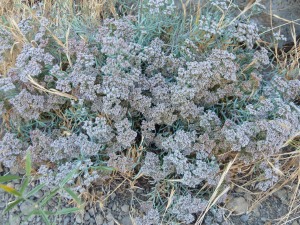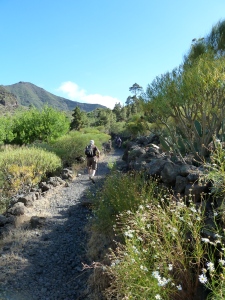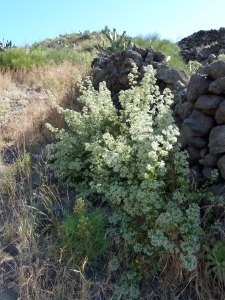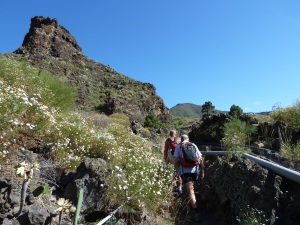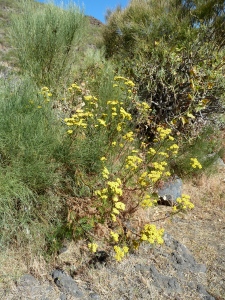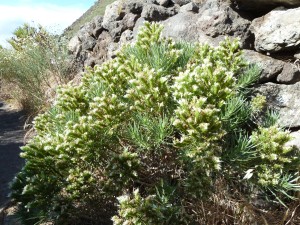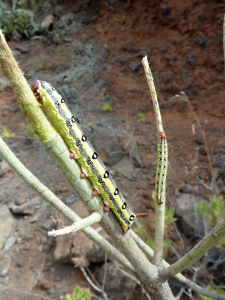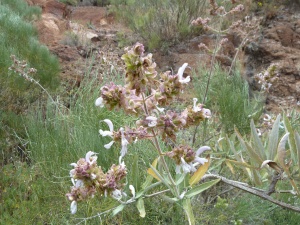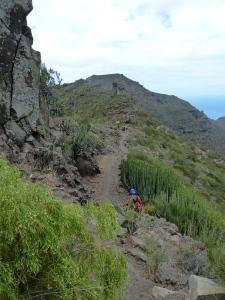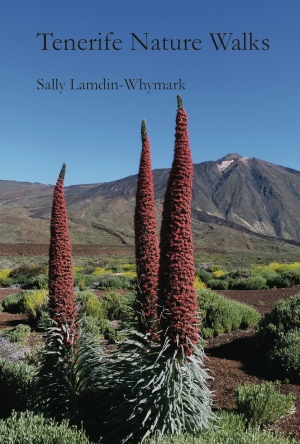Blog Archives
Camino real route from Guia de Isora to Arguayo and return via Chiguergue
I have lived in Guia de Isora area for 11 years, and walked a great many different footpaths in the area, but have long wanted to walk a part of the south Camino Real (Royal Road) from Guia to Chio. However, I did not know where the Camino Real went after Chio and was delighted to see the route from Guia de Isora as far as Santiago del Teide posted in Wikiloc.com by user ‘tinijoma’. So I planned a walk which followed the Camino Real as far as Arguayo and returned by other footpaths, already known to us, slightly higher up.
The Camino Real is part of a network of ‘royal roads’ which were directed by the king to be built by the landowners who had been given large areas of land as rewards for participating in the conquest of the island. They were the motorways of the day, linking all the main settlements with wide cobbled paths, enabling communication and trade.
I walked this route on May 25th with two friends but had not got around to doing a blog about it till now, but wanted to share it as it was an interesting walk both culturally and botanically.
A lot of the botanical interest was that it was the flowering time of the Tenerife endemic Giant Houseleeks – Bejeques in spanish – (Aeonium urbicum ssp meridionale). These plants are short-lived perennials which produce a rosette of succulent leaves on a thick stalk, and may survive several years before producing a large head of flowers and then dying. They grow on the recent lava flows, and other rocky areas, where few other plants are able to survive. Some years there are relatively few in flower, but this year there are huge numbers. Jeff Ollerton, an environmental scientist who does research in Tenerife believes the years when there are a lot in flower occur after a dry winter, and is doing a study to test this hypothesis.
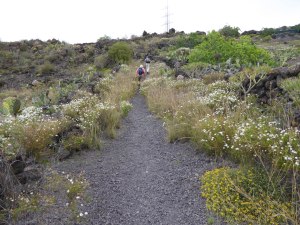
The Camino Real starting the ascent to Arguayo with Tenerife Birds Foot Trefoil (Lotus campylocladus) and marguerites (Argyranthemum spp) along the route
We started our walk from the end of the Avenida de la Constitucion, which is a dead end road on which the Health Centre (Centro de Salud) and a couple of schools are found. My friends call it the ‘road to nowhere’! So it is easy to park towards the far end! We started by heading downhill on a track which appeared at first to be a private drive, not far from the end of the road. However, the track continues beyond the house it passes on a bend and continues down to the TF-82 main road between Guia de Isora and Chio.
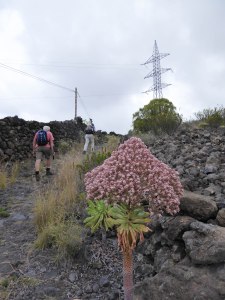
This specimen of the Giant Houseleek (Aeonium urbicum ssp meridionale) beside the path is a particularly strong pink colour
On reaching the road I realised that instead of crossing it onto another track below the road we had to turn right and walk along the road for some 100m before turning off left onto the Camino Real, which was a single lane tarmac road at first, changing later to dirt track, and later still, a footpath. If you are not happy walking along a fairly busy road (though not so busy as it was before the opening of the new road TF-1) for this distance you could start the walk up in Chiguergue and avoid it, though this would shorten the walk also.
The Camino Real follows a route below the old TF-82 road and above the new part of the TF-1 road between Guia de Isora and Chio, with some good views down to the new road. Then it climbs steeply up to the village of Chio with huge cobble stones, but not always in place, so this stretch was a bit rough underfoot. Then we walked through the village passing the church on our left and continuing roughly straight on till we left the other side of the village. Then the route grew closer to the new road, ending up at the top of the embankment of the slip road off the road to the Chio junction, finally crossing the TF-82 at a diagonal as it goes down to cross the TF-1.
Then the ascent towards Arguayo began, climbing over malpais, joining the TF-375 road to Arguayo (now quite quiet, with the new road and tunnel), crossing it, and crossing back onto a track past some houses, and joining tarmac as we reached and crossed the TF-375 road again to leave the Camino Real and start our return.
We did not go into the village of Arguayo, where you can find shops and bars if you want some food or drink, and could go to visit the pottery museum where you can watch demonstrations of traditional local pottery making. Instead we turned right and walked down in front of the cemetry and took the next track on the left. We followed this track, and the path that continued where the track stopped, through to Chio, taking care on the downhill slope into the village.
Arriving at the TF-82 where it goes through the top of Chio, we turned left and walked along the main road for some hundreds of yards till nearly at the end of the village, just before the pharmacy, we turned left up an initially steep narrow road past Chio’s cemetery. We continued along the narrow road, tarmac at first, then track, then cobbled footpath, until we reached more tarmac just before the village of Chiguergue.
We reached the junction with another small tarmac road, went right and continued on the same road through the top of the village and out the other side. Note that if you want refreshments in Chiguergue you need to go to the bottom of the village. The narrow tarmac road continues towards Aripe through countryside with odd farmhouses. Immediately under a high wall of one of these houses we took a path which wound its way past a vineyard and other fields down to the road where we parked. This path is not well marked and difficult to describe so you need the GPS track to find it easily.
The GPS track of our walk can be found at the link below:
http://www.wikiloc.com/wikiloc/view.do?id=13445979
The route is 14.59km / 9.1 ml long with 510m /1675ft of ascent and descent and took 3 of us 4.5 hours to complete.
A flowery spring walk from Tamaimo up the Santiago valley
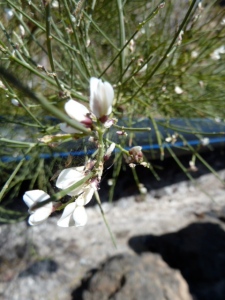
A Retama flower (Retama raetam) beside the irrigation channel next to the path. The Retama bushes had very few flowers in this area this year.
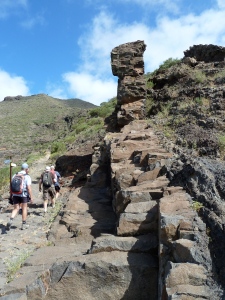
The path out of El Molledo passes by this wide dyke of (formerly!) molten rock intruded into existing rock.
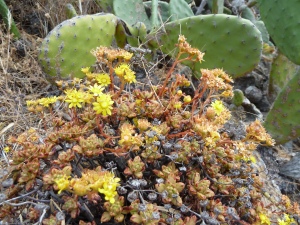
Aeonium sedifolium growing on another dyke running along the top of the ridge to the north of Tamaimo
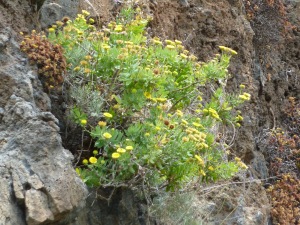
Tenerife samphire (Vieraea laevigata) growing on the rocky cliffs above the path descending to Tamaimo. It is a Tenerife endemic found only in the Teno region
These last two weeks I have been very busy and I am going away again in a couple of days, so I do not have time to write a full description of the walks I have done recently which have been so enjoyable with all the spring flowers to see. So I am just posting the photos to give my followers an idea of the flowers that I have seen.
